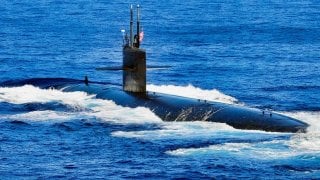The Los Angeles-Class: The Submarines That Made Russia Sweat
Designed as an attack submarine, the Los Angeles-class is equipped for anti-submarine warfare (ASW), intelligence gathering, show-of-force missions, insertion of special forces, strike missions, mining and search and rescue operations.
The Los-Angeles Class: Meet The Backbone of the U.S. Navy's Submarine Force: In November 1976, just days after Jimmy Carter was elected the 39th president of the United States, the USS Los Angeles (SSN-668) was commissioned. She was the first of a then-new class of submarines that would become the backbone of the U.S. Navy's submarine force at a time when the Soviet Union was the top national security threat. Just six months later, on May 27, 1977, President Carter and the First Lady were hosted onboard the submarine for an at-sea demonstration of her capabilities.
By 1996, the United States Navy took delivery of 62 of its Los Angeles-class nuclear-powered fast attack submarines (SSN). Also known as the 688 – pronounced " Six-Eighty-Eight" after the hull of the lead boat – the submarines were built by Northrop Grumman Ship Systems (formerly Newport News Shipbuilding) and General Dynamics Electric Boat Division. Today, more than five decades after SSN-668 was laid down in Newport News, Virginia, there are still 28 of the class in active service – more than other class in the world.
Los Angeles-Class - Small Undersea Home For Many
Each of the Los Angeles-class boats are just 362 feet in length but are home to a crew of 143 sailors, including 16 officers and 127 enlisted. Enough food is carried on each submarine to feed the crew for as long as ninety days.
Powered by a S6G nuclear reactor with two steam turbines, single shaft, which provides a surface speed of 20 knots (23 mph), and an official submerged speed of 20 knots as well, but also a reported and unofficial 33+ knots submerged. The nuclear power plant also provides the boats with the ability to remain deployed and submerged for extended periods of time. The subs are further outfitted with auxiliary equipment, including atmosphere control equipment that can replenish the oxygen used by the crew, while two distilling plants can convert salt water to fresh water for drinking, washing and for use in the propulsion plant.
Unique to the U.S. Navy's class was the choice of naming, with nearly every one of the submarines named after American cities and towns, rather than the traditional name for attack submarines, which have previously been named after marine animals.
A notable exception to the 688 boats was the USS Hyman G. Rickover (SSN-709), which was named after U.S. Adm. Hyman G. Rickover, who was a pioneer of the nuclear navy. Built by the Electric Boat Division of General Dynamics, SSN-709 was launched in 1983 and commissioned a year later. The boat was featured prominently in the documentary "Submarine: Steel Boats-Iron Men" filmed in 1989. She was decommissioned and stricken from the Navy roles in December 2006.
The Los Angeles-Class Attack Submarine
Designed as an attack submarine, the Los Angeles-class is equipped for anti-submarine warfare (ASW), intelligence gathering, show-of-force missions, insertion of special forces, strike missions, mining and search and rescue operations. Moreover, all of the submarines of the class built since 1982 are also equipped with a vertical launch missile system with a dozen launch tubes; and are further fitted with a Raytheon CCS Mark 2 combat data system.
The 688s can be equipped with both the land-attack and anti-ship version of Raytheon's Tomahawk missiles, while the land-attack version has a range of 2,500 km.
Nine of the boats were deployed during the Gulf War in 1991, during which time Tomahawk missiles were launched from two of the boats at Iraqi targets. Twelve Los Angeles-class submarines were subsequently deployed in support of Operation Iraqi Freedom in March/April 2003, and all of those subs launched Tomahawk TLAM missiles at targets inside of Iraq.
The Los Angeles-class can also carry Boeing's Harpoon anti-ship mission, which utilized active radar homing to deliver the 225kg warhead. The high subsonic missile has a range of 130 km. The boats can also lay Mobile Mark 67 and Captor Mark 60 mines.
Los Angeles-Class: The Sub That Can Do It All?
According to Naval Technology, the 688 submarines are equipped with a comprehensive suite of sonars: TB-23/29 thin line passive towed array (to be replaced by the Lockheed Martin TB-29A under development), BQG 5D wide aperture flank array, BQQ 5D/E low frequency passive and active search, and attack sonar, Ametek BQS 15 close range high-frequency active sonar also used for ice detection, MIDAS (Mine and Ice Detection Avoidance) System high-frequency active sonar and Raytheon SADS-TG active detection sonar.
While the Seawolf- class was meant to be the intended successor to the Los Angeles-class, the Seawolf program was scaled back at the end of the Cold War with just three boats completed. As such, the 688 subs will likely keep sailing for a few more years to come.
About the Author
Peter Suciu is a Michigan-based writer who has contributed to more than four dozen magazines, newspapers and websites. He regularly writes about military hardware, and is the author of several books on military headgear including A Gallery of Military Headdress, which is available on Amazon.com. Peter is also a Contributing Writer for Forbes.


